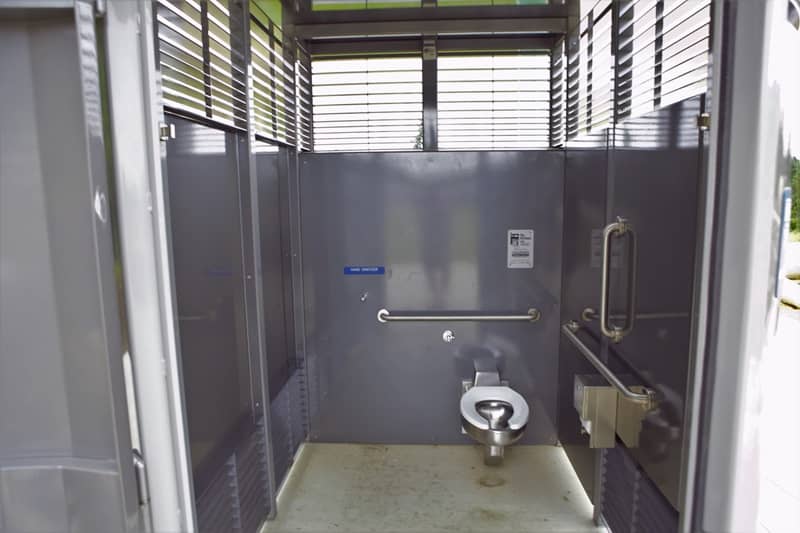Installing a public toilet isn’t as cut and dry as you would imagine. There are numerous public restroom laws and regulations officials must follow. Several local, state, and federal codes determine nearly every aspect of a restroom from the fixtures and plumbing to the layout and accessibility. These regulations are designed to make facilities energy-efficient, durable, and accommodating for users. Let’s dive into the vast sea of public restroom laws to see how cities can navigate their way to serve the public while respecting the law.
Americans with Disabilities Act (ADA)
What’s the purpose?
The Americans with Disabilities Act (ADA) is a piece of federal legislation designed to ensure individuals with disabilities have equal opportunities. Passed in 1990 and amended in 2008, this broad law covers everything from public services and private employment to transportation and beyond. Public restrooms must meet ADA requirements so all members of the public can access and use the facilities comfortably.
Further Reading: Why the Portland Loo is the Most Inclusive Public Bathroom in the World
ADA Public Restroom Laws
Stall Dimensions – Stalls must be at least 60” x 56” to accommodate wheelchair users.
Grab Bars – Grab bars need to be installed to support individuals with mobility issues.
Toilet Height – Toilet seats should be between 17” and 19” above the floor to allow for easier sitting and standing.
Sink Accessibility – Sinks must be at a sufficient height and offer knee clearance for wheelchair users.
Clear Floor Space – Floor space in public restrooms must be clear enough to maneuver wheelchairs and walkers.
International Plumbing Code (IPC)
What’s the purpose?
The International Plumbing Code (IPC) is the premier standard for plumbing design, functionality, and technology. In fact, it’s the most widely adopted plumbing code in the United States. While it’s not federally implemented, it’s adopted by over 37 states at some level. Other states and counties adhere to the Uniform Plumbing Code (UPC). These codes result in public restroom laws once officially codified through legislation.
IPC Public Restroom Laws
Fixture Requirements – There needs to be sufficient toilets and sinks based on how many people use them.
Water Supply and Distribution – Plumbing systems should provide a safe and steady flow of clean water to all the fixtures with properly sized pipes.
Sanitary Drainage – The drainage setup must be designed to get rid of wastewater and prevent any backflow.
Vent Systems – Vent systems need to be installed to safely let out sewer gases and keep the traps working effectively.
Backflow Prevention – Devices should be in place to prevent any contaminated water from flowing back into the clean water supply.
Nonpotable Water Systems – Nonpotable water systems must be clearly marked and kept separate from drinking water systems to avoid any mix-ups.
Occupational Safety and Health Administration (OSHA)
What’s the purpose?
The Occupational Safety and Health Administration (OSHA) isn’t just a piece of legislation or organization; it’s an official arm of the US Department of Labor. OSHA’s main function is to protect the safety and well-being of employees on worksites. While that focus extends far beyond public restrooms, there are plenty of OSHA regulations that impact the installation and maintenance of these facilities.
OSHA Public Restroom Laws
Hazard Communication – Hazardous chemicals used to clean restrooms must be properly labeled.
Personal Protective Equipment (PPE) – Workers must wear PPE when handling hazardous materials or performing maintenance tasks.
Ventilation Requirements – Restrooms must have proper ventilation to maintain air quality and minimize the buildup of harmful fumes and odors.
Electrical Safety – Teams must follow electrical safety standards for installing and maintaining restroom lighting and other electrical fixtures.
The Portland Loo Exceeds Public Restroom Laws
Conventional public restrooms often do the bare minimum to meet these requirements, leaving the public and city officials wanting. The Portland Loo is revolutionizing what people expect from a toilet by going above and beyond public restroom laws. These units strike the perfect balance between user comfort and a city’s needs. Find out why the Loo is getting installed in cities across the country and the world!


